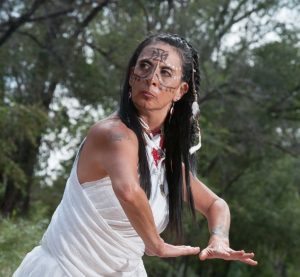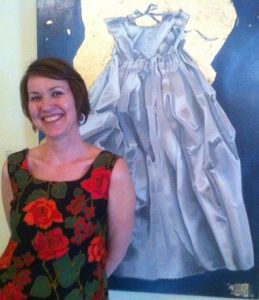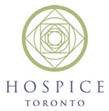Hospice Toronto’s Expressive Arts Therapy Program: Body Mapping
Within our Expressive Arts Therapy programs at PWA one of the successful and impactful programs is Body Mapping. Body Mapping is a tool created in Tanzania by a woman who was working with people living with HIV. It is a particular way of telling your story artistically through your own body. To meditate and be in our bodies to start analyzing, start digging a little bit about “
Where am I?” “What am I willing to express and to share with the rest of the group?” And to feel that we are all here on the same level and the same purpose.
We recently sat down with Norma Araiza Expressive Arts Therapist/Coordinator from Hospice Toronto and Karin Foulds, Expressive Arts Therapist Volunteer. Hospice Toronto Partners with PWA to offer a variety of programs for clients.
PD: Norma, please start by telling us who you are.
 Norma: I am a Mexican Indigenous woman, a mom, and an Expressive Arts Therapist. Also, I am an artist focusing on dance and theatre. That is my passion. And I incorporate that into Expressive Arts Therapy. For a few years I’ve been coming to Toronto PWA with Expressive Arts Therapy in different ways, sometimes in groups. I facilitate a series of sessions where every week we do something different. I’ve done an intensive group of Arts Therapy where we have built up from one day to another into a particular project. When I do groups, as with Body Mapping, it is something very specific, lately we’ve been coming on the Essential Market days every other week.
Norma: I am a Mexican Indigenous woman, a mom, and an Expressive Arts Therapist. Also, I am an artist focusing on dance and theatre. That is my passion. And I incorporate that into Expressive Arts Therapy. For a few years I’ve been coming to Toronto PWA with Expressive Arts Therapy in different ways, sometimes in groups. I facilitate a series of sessions where every week we do something different. I’ve done an intensive group of Arts Therapy where we have built up from one day to another into a particular project. When I do groups, as with Body Mapping, it is something very specific, lately we’ve been coming on the Essential Market days every other week.
Karin: I think it’s like an ‘outreach’ to engage in the PHA community. Just to loosen them up. And talk using art, art making, and perhaps to enlighten them through art.
PD: And what better way than the Essential Market days while clients are waiting to be taken into the Market. I also saw you both at the Holiday Bag Day this past December, which was exciting for clients. It was a nice long busy day. It was great to see you both there involved at the Expressive Arts Therapy table.
Norma: Yes. It was so much fun. I find that over the year’s clients of PWA are starting to recognize us. And they know what we’re doing. So, they are not as afraid as before because they wouldn’t be close to the table at first. And now people are more curious with time, and we know some people by name. So, it seems they know Expressive Arts Therapy now. People are getting used to us. They know it’s ok to do whatever on a piece of paper without any agenda, without any pressure or any particular talent because that’s what they were afraid of, that they are not an artist. “I’ve never done this.” And so what we are trying to do is for them to explore their own expression in a very simple way.
PD: You mentioned that the clients might be afraid because of the art aspect, of being artistic. It may also be some PHA’s lack the extra funds for something wonderful like Expressive Arts Therapy in their lives outside PWA. They may think a cost is involved.
Norma: I see. I never thought of that actually, and that’s my own assumption, because the services PWA offers are usually free to clients. Hospice Toronto is a valued partner which is why they make available these programs to the HIV/AIDS Community.
PD: I think it’s a humble thing. Some clients have had difficult experiences going through “other outside services”. It’s that humble inner voice forever asking, “How much?”
Norma: Yes. I think the fear comes at different levels. But, mostly what I notice is when we invite people, “Would you like to come and express yourselves somehow?” and “Would you like to imprint something? And they say, “Oh, no thank-you. I don’t know what to do.” “I’m not inspired.” or, “I’m afraid it’s not going to be good”. “I’m not an artist”. So we have a lot of that.
PD: When that happens what do you suggest, a colour to use or a type of painting to do?
Norma: For me it depends on how I feel with the person at the moment. It’s how I approach them. If I feel that that person doesn’t want to engage with me I leave them alone. I don’t insist. Sometimes I say, “You don’t need to have any artistic talent. You don’t need anything – you just need the will to put even a line or a circle on the paper.” And that is enough. And sometimes I invite them to do it together. Show them what others have done. Convince them a bit in a very light way, never being pushy.
PD: Karin, do you want to tell us who you are?
 Karin: I’m a student with Create Institute. And I’ve been fortunate enough to be working in the last year and a half under Norma’s supervision as a practicum with Hospice Toronto. At 55 I found myself to be an emerging artist. When I was younger I went to art school. I’m a painter by background. Then I didn’t create for a number of years. In my mid-forties I found that calling to make art again. I found it so strong. I needed to have art in my life more fully and that’s why I went to the Create Institute and became an Expressive Arts Therapist because it uses all of the modalities, movement, sound-making, it’s any kind of art making. And I love being with Norma.
Karin: I’m a student with Create Institute. And I’ve been fortunate enough to be working in the last year and a half under Norma’s supervision as a practicum with Hospice Toronto. At 55 I found myself to be an emerging artist. When I was younger I went to art school. I’m a painter by background. Then I didn’t create for a number of years. In my mid-forties I found that calling to make art again. I found it so strong. I needed to have art in my life more fully and that’s why I went to the Create Institute and became an Expressive Arts Therapist because it uses all of the modalities, movement, sound-making, it’s any kind of art making. And I love being with Norma.
I’ve found coming to Toronto PWA has meant a great deal to me. I look forward to coming to these sessions. I enjoy the interactions with people here. For example when I initiate mark-making (tic-tac-toe) I put a mark down – and at some point someone will engage back. It’s almost like a little challenge to myself. I’ll think, “I wonder if I’ll be able have this person engage with me?” in mark-making. Even in cutting things. I’ve found that when we cut random objects or shapes that this seems to be less intimidating than using the pastels or paints.
PD: It’s interesting when you and Norma talk of being present at PWA and you can almost hear the stigma toward HIV being peeled away. Because so much is hidden and unseen of the stigma faced each day by a person living with HIV.
Karin: I also enjoy working the room, in a way, I like to see who’s in the room, to catch their eye or to see if I can bring them to the table.
Norma: It’s a little bit of artistic flirting.
Karin: Yes! That’s what it is. Like a flirtatious engagement with the arts. And it is also not necessarily mark-making or painting or cutting shapes out. It can also be poetry too. There are several people who have engaged in that way. Writing words down. Then they start to create from the words.
PD: Having been in the Body Mapping class I could see the positive effect from PHA’s, out of all the artistic expressions why Body Mapping?
Norma: Body Mapping is a very powerful tool that I’ve used at different agencies and particularly at ASO’s. And I see it really helps people to do an inner check with themselves, where they are in that moment. When I met with Suzanne Paddock, Interim Executive Director and Nick Papadogiannis, Holistic Engagement Coordinator about programming, they agreed that Expressive Art Therapy was making an impact at PWA. They asked what additional workshops can we do, I suggested Body Mapping. Other sessions had been done but not Body Mapping. It was agreed and that’s how it came about.
PD: Please tell the readers what Body Mapping is.
Norma: Body Mapping is a tool created in Tanzania by a woman who was working with people living with HIV, mainly women. She started with women. I’m not sure if she created it but it was the first time that people knew that there was this particular way of telling your story artistically through your own body. And to meditate and be in our bodies to start analyzing, start digging a little bit about “Where am I?” “What am I willing to express and to share with the rest of the group?” And to feel that we are all here on the same level and the same purpose.
We start with a meditation as a check-in using the arts then we immerse into that vocabulary. Body mapping is really exploring and expressing oneself through the arts – pictures, painting and visuals. You are colouring and pasting things onto your own body to represent where you are at on the diagram. You have a very big piece of paper the size of a person. You lay down on the paper. I ask the person who is on the floor, “How would you like to be represented?” You adopt that position, a pose. Your partner then traces with a marker/pen your entire body outline. And that is the picture that he or she is going to be artistically decorating. And then through a particular technique you go through different layers and different aspects of Body Mapping using art. It depends on time. You can go very deep, or you can just go superficially – by brushing on certain themes. It is still very powerful because it asks us to wonder where we are at presently, and what are our feelings presently? What is our process? It’s a complete check of where am I at in my process or life? How am I taking this? How do I live with it? What aspects affect me more? What aspects I have passed in terms of the trauma. Did I move on from it and different aspects of a whole person.
And that is what Body Mapping is.
PD: Karin do you want to add anything to that?
Karin: Can I explain the feeling of the tracing? To the participants body laying on the paper? The act of tracing and feeling that light touch near my body by my partner, that I was being traced or outlined. That in itself was powerful. And there was a connection made. Not just to the group but also to the partner, the tracing or outlining.
Norma: It’s one thing to be traced on the paper. But then there is the feeling of tracing your partner because it’s a different feeling.
Karin: Yes wanting to represent the partner in a respectful way to honour them.
PD: Looking around the room you could see electric colours illuminate from different people. Like their auras doing different things. It was exciting.
Norma: Yes. You can also see the difference of, and not in a judgemental way, who is more confident. Who is more careful of touch and being touched when they were laying down because laying down is a vulnerable position. I’m always very grateful when people are willing to do it and trusting the process and trusting me. To me it’s a great honour and facilitating this is very powerful for me to witness this sharing.
PD: There was a bonding that happened naturally among the participants. Could you both expand on that and why you think it occurs?
Norma: In my opinion it is a natural thing to happen. When you have something in common, even though it is a very personal journey, it’s the recognition that there are other people who are doing what I’m doing. And we’re supporting each other even though one may be concentrated on their own Body Mapping because we’re in the same space and sharing.
PD: What do you see through their eyes?
Norma: I see at the beginning a little bit of pain. Then I see the fun and confidence. I see wonder and the eagerness to share their personal stories.
Karin: There is great deal of curiosity to see how the session will unfold. That’s what I see. For myself being able to participate, though I don’t share the same journey, I could bring my own trauma and speak to it. I found that meant a lot to me. And I felt really held by everyone there. I felt I was cared about and held very well. It was a wonderful experience being able to share.
PD: You could feel the embrace because there is no competition. Just support with another, It was lovely.
Norma: I found there was a curiosity. What is the other person doing? In how he/she is expressing because we as individuals go through very different roads.
Karin: Their own journey’s.
Norma: I think that curiosity is also asking, “Ok, I’m doing this, I’m working with family. This is very interesting.” So, it’s also a source of inspiration I find nurturing each other and that also helps to create the bonding.
PD: This was a 2-day workshop. Having the art pieces complete. What do you think the PHA’s outcome is? How do you feel they benefited once complete? Do you feel they are richer?
Norma: Well, I think there is a higher level of awareness. It’s very hard to say because it’s very subjective. Everybody has a different experience. Depending on the level of deepness they are willing to go to.
PD: Do you think each individual knows themselves a little bit better when they leave than when they first came in through Body Mapping?
Norma: I would like to believe that. I really would like to believe that. At least I think people leave with more questions. And I find that more questions are good.
Karin: Perhaps some surprises too that come up. Not just about themselves, but about the group and how each person supported the other. Like that nurturing that came out. That was quite a surprise.
PD: As a tool, do you think a PHA can utilize Body Mapping daily to express and relax more?
Norma: I think it is exactly that, a tool for them to bring out every time they would like to express something. I think it gives them permission to use the arts without needing words in a more traditional way for expression. That particular session was very powerful for me, as a witness and as a facilitator holding the space for the group. I learned a lot. Even though I am not participating directly I find it really helps me to grow and to have a perspective of my surroundings and the bonding with people.
Karin: I like what she said about feeling more human. It was such an intimate and laying-bear of themselves. Almost a declaration of, “Here I am. Here is my journey.” It was really beautiful, when I came home with the image I created – I was so excited. I still have it in my studio. With a great deal of pride friends who’ve visited are drawn to this image, over all my other pieces. This speaks so much to who you are.
The tool of Body Mapping is actually a tool to use toward a purpose of healing me, I was able to look at it from the outside and proceed forward with my life. Watching others and seeing other peers there I hadn’t seen in a while.
What is left with me is the effect – information is knowledge – I am responsible for the knowledge. I think it is not to keep the information to ourselves but to share it with others. When I experience something – I think it will help other peers. Then I want to implement it. I start looking for other opportunities to use it.
– WORKSHOP PARTICIPANT
